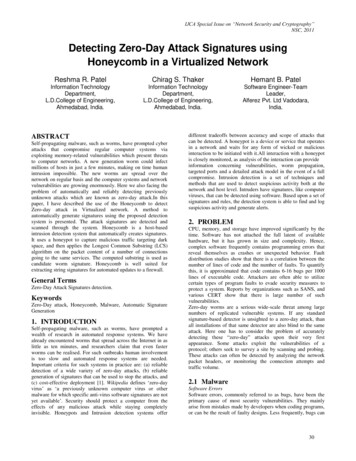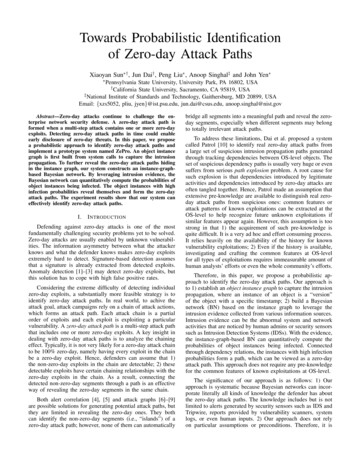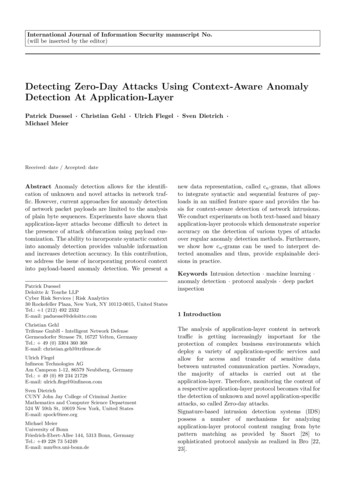
Transcription
IJCA Special Issue on “Network Security and Cryptography”NSC, 2011Detecting Zero-Day Attack Signatures usingHoneycomb in a Virtualized NetworkReshma R. PatelChirag S. ThakerHemant B. PatelInformation TechnologyDepartment,L.D.College of Engineering,Ahmedabad, India.Information TechnologyDepartment,L.D.College of Engineering,Ahmedabad, India.Software Engineer-TeamLeader,Alferez Pvt. Ltd Vadodara,India.ABSTRACTSelf-propagating malware, such as worms, have prompted cyberattacks that compromise regular computer systems viaexploiting memory-related vulnerabilities which present threatsto computer networks. A new generation worm could infectmillions of hosts in just a few minutes, making on time humanintrusion impossible. The new worms are spread over thenetwork on regular basis and the computer systems and networkvulnerabilities are growing enormously. Here we also facing theproblem of automatically and reliably detecting previouslyunknown attacks which are known as zero-day attack.In thispaper, I have described the use of the Honeycomb to detectZero-day attack in Virtualized network. A method toautomatically generate signatures using the proposed detectionsystem is presented. The attack signatures are detected andscanned through the system. Honeycomb is a host-basedintrusion detection system that automatically creates signatures.It uses a honeypot to capture malicious traffic targeting darkspace, and then applies the Longest Common Substring (LCS)algorithm on the packet content of a number of connectionsgoing to the same services. The computed substring is used ascandidate worm signature. Honeycomb is well suited forextracting string signatures for automated updates to a firewall.General TermsZero-Day Attack Signatures detection.KeywordsZero-Day attack, Honeycomb, Malware, Automatic SignatureGeneration1. INTRODUCTIONSelf-propagating malware, such as worms, have prompted awealth of research in automated response systems. We havealready encountered worms that spread across the Internet in aslittle as ten minutes, and researchers claim that even fasterworms can be realised. For such outbreaks human involvementis too slow and automated response systems are needed.Important criteria for such systems in practice are: (a) reliabledetection of a wide variety of zero-day attacks, (b) reliablegeneration of signatures that can be used to stop the attacks, and(c) cost-effective deployment [1]. Wikipedia defines „zero-dayvirus‟ as „a previously unknown computer virus or othermalware for which specific anti-virus software signatures are notyet available‟. Security should protect a computer from theeffects of any malicious attack while staying completelyinvisible. Honeypots and Intrusion detection systems offerdifferent tradeoffs between accuracy and scope of attacks thatcan be detected. A honeypot is a device or service that operatesin a network and waits for any form of wicked or maliciousinteraction to be initiated with it.All interaction with a honeypotis closely monitored, as analysis of the interaction can provideinformation concerning vulnerabilities, worm propagation,targeted ports and a detailed attack model in the event of a fullcompromise. Intrusion detection is a set of techniques andmethods that are used to detect suspicious activity both at thenetwork and host level. Intruders have signatures, like computerviruses, that can be detected using software. Based upon a set ofsignatures and rules, the detection system is able to find and logsuspicious activity and generate alerts.2. PROBLEMCPU, memory, and storage have improved significantly by thetime. Software has not attached the full latent of availablehardware, but it has grown in size and complexity. Hence,complex software frequently contains programming errors thatreveal themselves as crashes or unexpected behavior. Faultdistribution studies show that there is a correlation between thenumber of lines of code and the number of faults. To quantifythis, it is approximated that code contains 6-16 bugs per 1000lines of executable code. Attackers are often able to utilizecertain types of program faults to evade security measures toprotect a system. Reports by organizations such as SANS, andvarious CERT show that there is large number of suchvulnerabilities.Zero-day worms are a serious wide-scale threat among largenumbers of replicated vulnerable systems. If any standardsignature-based detector is unsighted to a zero-day attack, thanall installations of that same detector are also blind to the sameattack. Here one has to consider the problem of accuratelydetecting these “zero-day” attacks upon their very firstappearance. Some attacks exploit the vulnerabilities of aprotocol; others seek to survey a site by scanning and probing.These attacks can often be detected by analyzing the networkpacket headers, or monitoring the connection attempts andtraffic volume.2.1 MalwareSoftware ErrorsSoftware errors, commonly referred to as bugs, have been theprimary cause of most security vulnerabilities. They mainlyarise from mistakes made by developers when coding programs,or can be the result of faulty designs. Less frequently, bugs can30
IJCA Special Issue on “Network Security and Cryptography”NSC, 2011be introduced by a compiler that produces incorrect binary codeeven when given sound source code.Buffer OverflowsA frequently encountered memory access error that results instoring data in a different location than the one intended by theprogrammer is a buffer overflow. Such errors usually occurwhen copying data between buffers without checking their size.Format String ErrorsA less common memory error can occur when an invalid formatstring is used with the printf(format, .) family of functions.These functions produce string output that can be printed instandard output, or written to a string buffer or a file. The outputis created according to the string in the format argument. Thefunction accepts a variable number of arguments, which arestored in the stack. As the format string is processed, thearguments are retrieved from the stack to produce the output.WormA worm is a program that propagates across a network byexploiting security awes of machines in the network. The keydifference between a worm and a virus is that a worm isautonomous. That is, the spread of active worms does not needany human interaction. As a result, active worms can spread inas fast as a few minutes. The propagation of active wormsenables one to control millions of hosts by launching distributeddenial of service (DDOS) attacks, accessing confidentialinformation, and destroying/corrupting valuable data. Accurateand prompt detection of active worms is critical for mitigatingthe impact of worm activities.A worm is a program that propagates across a network byexploiting security awes of machines in the network. The keydifference between a worm and a virus is that a worm isautonomous. That is, the spread of active worms does not needany human interaction. As a result, active worms can spread inas fast as a few minutes. The propagation of active wormsenables one to control millions of hosts by launching distributeddenial of service (DDOS) attacks, accessing confidentialinformation, and destroying/corrupting valuable data. Accurateand prompt detection of active worms is critical for mitigatingthe impact of worm activities.Self-propagating MalwareA particularly malicious threat against computer systems is thatof self-propagating malware or worms. Internet worms such asCodeRed, Blaster, and Sasser have created havoc in the past,while recently the Conficker worm has also made the news onvarious occasions by infecting various high-profile targets.Worms are malicious code that use various infection techniquesto compromise systems, and are able to self-replicate by locatingand compromising new targets without the user taking anyaction. Table 1 shows GFI Software has announced the top 10most prevalent malware threats for the month of February2011as detected by scans performed by its anti-malwaresolution, VIPRE Antivirus, and its antispyware tool,CounterSpy.Payload The program that implements the desired functionalityof any malware, besides the infection of the target, is thepayload. The payload of an attack is also called shellcode forhistorical reasons, as it was frequently used by attackers toacquire a remote shell on the compromised system.2.2 Zero-Day AttackWikipedia defines „zero-day virus‟ as „a previously unknowncomputer virus or other malware for which specific anti-virussoftware signatures are not yet available‟. According toWikipedia, „a zero-day attack or threat is a computer threat thattries to exploit computer application vulnerabilities that areunknown to others or undisclosed to the software developer‟.There is also a notion of a vulnerability window which is thetime between the first exploitation of vulnerability and whensoftware developers start to develop a countermeasure to thatthreat. These definitions evaluate time points such as the attackrelease and the moment when the very first easing is available.In the field of Anti-Virus products the test of zero-day protectionis usually performed by using so-called proactive testingmethodology (also known as retrospective testing). Thisinvolves „freezing‟ a product (creating a snapshot andsubsequently denying the product the ability to receive updates)and then testing detection over attacks which appeared after thefreeze point. In this scenario the frozen product will only faceunknown threats and therefore all the reactive capabilities willbe excluded from the test.3. DEFENCESAs documented by SANS, "Vulnerabilities are the gateways bywhich threats are manifested" .In other words, a systemcompromise can occur through a weakness found in a system. s/exposures in order to apply a patch or fix to preventa compromise. There are two points to consider:Many systems are shipped with: known and unknown securityholes and bugs, and insecure default settings (passwords, etc.).Much vulnerability occurs as a result of misconfigurations bysystem administrators.Ways to counteract these conditions include:1) Creating and surviving by baseline security standards,2) Installing vendor patches (when appropriate),3) Vulnerability scanning,4) Subscribing to and abiding by security advisories,5) Implementing perimeter defenses, such as firewalls and routerACLs,6) Implementing intrusion detection systems and virus scanningsoftware.There are several methods that are used to find new securityvulnerabilities: Source code analysis Binary file analysiso Static analysiso Dynamic (runtime) analysis Runtime analysis of API functions Fuzzing methods (fault injection) and Hybrid methods (various combinations of above methods).3.1 Intrusion Detection SystemIntrusion detection is a set of techniques and methods that areused to detect suspicious activity both at the network and hostlevel. Intrusion Detection System or IDS is software, hardwareor combination of both used to detect intruder activity. Snort is31
IJCA Special Issue on “Network Security and Cryptography”NSC, 2011an open source IDS available to the general public. Intrusiondetection systems fall into two basic categories: Signature-based intrusion detection systems Anomaly detection systems.Signature-Based intrusion Detection System:Intruders have signatures, like computer viruses, that can bedetected using software. You try to find data packets thatcontain any known intrusion-related signatures or anomaliesrelated to Internet protocols. Based upon a set of signaturesand rules, the detection system is able to find and log suspiciousactivity and generate alerts.Anomaly Detection System:Anomaly-based intrusion detection usually depends on packetanomalies present in protocol header parts. In some cases thesemethods produce better results compared to signature-basedIDS.Signature:Signature is the pattern that you look for inside a data packet. Asignature is used to detect one or multiple types of attacks. Forexample, the presence of “scripts/iisadmin” in a packet going toyour web server may indicate an intruder activity. Signaturesmay be present in different parts of a data packet dependingupon the nature of the attack. For example, you can findsignatures in the IP header, transport layer header (TCP or UDPheader) and/or application layer header or payload.Usually IDS depends upon signatures to find out about intruderactivity. Some vendor-specific IDS need updates from thevendor to add new signatures when a new type of attack isdiscovered.Terminology Alert/Alarm: A signal suggesting that a system has been oris being attacked. True Positive: A legitimate attack which triggers an IDS toproduce an alarm. False Positive: An event signaling an IDS to produce analarm when no attack has taken place. False Negative: A failure of an IDS to detect an actualattack. True Negative: When no attack has taken place and no alarmis raised. Noise: Data or interference that can trigger a false positive. Site policy: Guidelines within an organization that controlthe rules and configurations of an IDS. Site policy awareness: An IDS's ability to dynamicallychange its rules and configurations in response to changingenvironmental activity. Confidence value: A value an organization places on an IDSbased on past performance and analysis to help determine itsability to effectively identify an attack. Alarm filtering: The process of categorizing attack alertsproduced from an IDS in order to distinguish false positivesfrom actual attacks. Attacker or Intruder: An entity who tries to find a way togain unauthorized access to information, inflict harm orengage in other malicious activities. Masquerader: A user who does not have the authority to asystem, but tries to access the information as an authorizeduser. They are generally outside users. Misfeasor: They are commonly internal users and can be oftwo types:o An authorized user with limited permissions.o A user with full permissions and whomisuses their powers.Clandestine user: A user who acts as a supervisor and triesto use his privileges so as to avoid being captured.3.2 HoneypotHoney pots are systems used to lure hackers by exposing knownvulnerabilities deliberately. Once a hacker finds a honey pot, itis more likely that the hacker will stick around for some time.During this time one can log hacker activities to find out his/heractions and techniques. This information can be used later on toharden security on actual servers.High-interaction honeypots consist of a real OS and applicationsrunning on hardware or under a VM whereas low-interactionhoneypots expose virtual OS and services to attackers. Multiplehosts can be simulated by a single low-interaction honeypotusing forged network stacks to simulate different OS, and scriptsthat perform simple protocol handling for simulated services.Honeypots are deployed to handle all or part of the unused IPaddress space in the network.The common services running on Honeypot are, like Telnetserver (port 23), Hyper Text Transfer Protocol (HTTP) server(port 80), and File Transfer Protocol (FTP) server (port 21) andso on. The honey pot is placed close to production server to lurethe attacker so that the attackers can assume it as for a realserver. Firewall and/or router is configured to redirect traffic onports to a honey pot where the intruder assumes connecting to areal server. The alert mechanism is created so that whenhoneypot is compromised, the alarm is triggered. The log files iskept on other machine so that when the honey pot iscompromised, the hacker does not have the ability to deletethese files.Virtual HoneypotA virtual honeypot is simulated by another machine. Virtualhoneypots are more flexible and scalable, since only a singlemachine can simulate many virtual honeypots that host differentoperating systems and services.HoneydHoneyd is a framework for virtual honeypots that simulatescomputer systems at the network level. Honeyd supports the IPprotocol suites and responds to network requests for its virtualhoneypots according to the services that are configured for eachvirtual honeypot. To simulate real networks, Honeyd createsvirtual networks that consist of arbitrary routing topologies withconfigurable link characteristics such as latency and packet loss.Subsystem VirtualizationHoneyd supports service virtualization by executing UNIXapplications as subsystems running in the virtual IP addressspace of a configured honeypot. This allows any networkapplication to dynamically bind ports, create TCP and UDPconnections using a virtual IP address. Subsystems arevirtualized by intercepting their network requests and redirectingthem to Honeyd. Every configuration template may containsubsystems that are started as separated processes when thetemplate is bound to a virtual IP address. An additional benefit32
IJCA Special Issue on “Network Security and Cryptography”NSC, 2011of this approach is the ability of honeypots to create periodicbackground traffic like requesting web pages and reading email,etc.There are certain disadvantages of honeypots: all network trafficreceived by a honeypot is considered by definition to besuspicious, as the system has an idle role and its existence is notadvertised. Unfortunately, even idle connected systems receiveplenty of noise traffic, which makes it harder for administratorsto identify malicious from innocuous traffic. To overcome thisissue, dynamic analysis systems have been brought into play tohost high-interaction honeypots.Another weakness of honeypots is that by design they supportattacks that perform target discovery through network scans. Astechnologies like IPv6 and network address translation (NAT)become more popular, scanning has become less efficient, andattackers have turned to other means to discover targets. As aresponse, we have witnessed the development of client-sidehoneypots, which by continuously connecting to remote servers(mostly web servers admittedly) attempt to discover maliciousones.Table 1. Top 10 Detections for February 2011 as reported byGFI Trojan.Win32.Generic.pak!cobraTrojan2.89%Zugo LTD (v)Adware2.52%Fraudtool.Win32.Securityshield.ek!c INF.Autorun (v)Trojan1.66%Worm.Win32.Downad.Gen (v)Worm1.48%Pinball Corporation (v)Adware1.19%Exploit.PDF-JS.Gen (v)PDFexploit0.83%3.3 HoneycombHoneycomb is realized as a Honeyd extension. It is based on theidea that any traffic directed to the honeypot can be consideredan attack. Figure 1 shows the high-level overview ofhoneycomb‟s signature creation algorithm. Honeycombautomatically generates Snort and Bro signatures for allincoming traffic. New signatures are created if a similar patterndoes not yet exist. Existing signatures are updated wheneversimilar traffic has been detected, so the quality of the signaturesis increased with each similar attack session. Signatures can beupdated to match mutations of existing attacks. For eachmutation a more generic description for the signature isgenerated, so that the original attack and the mutation are bothmatched. This way the signature base is kept small. Themechanism creates signatures for all traffic directed to thehoneypot. Unfortunately the attacks are not verified to besuccessful in any way. Therefore, it suffers of false positives ifany non-attack traffic is directed to the honeypot like e.g. theIPX protocol. A computer connected to the Internet especiallyon a dial-up connection is addressed even by non attack traffic.Whenever a search engine tries to mirror the host or a peer topeer program tries to connect, a signature is generated.Signatures must be checked manually afterwards whether theywere created for an attack or for something else. An approach toverify the attack patterns is desirable. The signature generationmechanism could be used to create IDS signatures if appropriateattack traffic is identified and directed to the system.Pattern Detection in flow content:Honeycomb applies LCS algorithm to binary strings builtout of exchanged messages using the following two methods:Horizontal detection:Assume that the number of messages in the currentconnection after the connection state update is n.Honeycomb then attempts pattern detection on the nthmessages of all currently stored connections with the samedestination port at the honeypot by applying the LCS algorithmto the payload strings directly.Vertical Detection:Honeycomb also concatenates incoming messages of anindividual connection up to a configurable maximum number ofbytes and feeds the concatenated messages of two differentconnections to the LCS algorithm. Vertical detection alsomasks TCP dynamics: the concatenation suppresses the effectsof slicing the communication flow into individual messages,which proved to be valuable.4. ALGORITHMS4.1 Dynamic Taint AnalysisDynamic taint analysis (DTA) is a mechanism to tracksincoming data from the network throughout the process. The untrusted data are marked as „tainted‟ originating from thenetwork. When operations on this data are performed, taint tagsare propagated to the result of such operations. An alert is raisedand relevant action is performed when data from a tainted pieceof memory is used in an important operation, for example astarget address in a jump.Tainting dataTainting of data can be done by adding an integrity bit to every32-bit word of memory. It then can use Biba's low-watermarkintegrity policy with values \high" and \low" to describe thelevel of threat the data poses.Taint propagationTaint propagation occurs when arithmetic is performed withtainted values, like for example a value xt is increased with thetainted variable n; the resulting yt is also tainted.xt n ytThe register is also marked tainted containing tainted memory.Logging of the „tainted‟ marks is generally done by adding somememory structures containing the tags for its memory section.Paging techniques can be used for optimization to lower theoverhead.33
IJCA Special Issue on “Network Security and Cryptography”NSC, 20114.2 LCS algorithmLongest Common Substring is a popular and fast algorithm fordetecting patterns between multiple strings used by automaticsignature generation projects. The algorithm finds the longestsubstring that is common to memory and traffic trace. Thelonger common substring is computed between two packets, forthe suspected anomalous similar incoming/outgoing packets.The main disadvantage is the computation overhead. LCS can beimplemented in linear time and avoids the fragmentationproblem and other small payload manipulations.Fig 1: High level overview of Honeycomb’s Signature Creation Algorithm5. CONCLUSIONIn this paper we have seen how the problem of wormpropagation arises into computer network, which isbasically due to software errors that incurred into softwarebinaries during development phase. The self propagatingmalware do not need any human intervention to propagateinto the network. Also, we have discovered how theunknown worm signatures are considered as Zero-Dayworm signatures. We have shown the possible defensessuch as Intrusion detection system and Honeypots. Honeypots are systems used to attract and fool the hackers byexposing known vulnerabilities by virtualzing the wellknown services. The two algorithms, Dynamic TaintAnalysis and LCS algorithm are capable to detect thesignature of known attacks. Honeycomb automaticallygenerates Snort and Bro signatures for all incoming trafficand new signatures are created if a similar pattern does notyet exist using LCS algorithm. Finally, Honeycomb whichis basically Honeyd extension can be effectively used todetect the unknown worm-”Zero-Day” signatures in thevirtualized network.6. ACKNOWLEDGMENTSI would like to thank Chirag S. Thaker to provide incessantguidance to my work and giving his valuable suggestionsregarding the research work methodology. I also like tothank Hemant Patel to guide me about software requiredfor the given project.7. REFERENCES[1] C. Xenakis a, C. Panos b, I. Stavrakakis b: Acomparative evaluation of intrusion detection34
International Journal of Computer Applications (0975 – 8887)Volume *– No.*, 2011architectures for mobile ad hoc networks, elsevier ,computers & security 30 ( 2011 ) 63 -80WSEAS International Conference on APPLIEDCOMPUTER SCIENCE (ACS'08)D. Dagon, X. Qin, G. Gu, W. Lee, J. Grizzard, J.Levine, and H. Owen. HoneyStat: Local WormDetection Using Honeypots. In Proceedings of the 7thInternational Symposium on Recent Advances inIntrusion Detection (RAID), pages 39-58, October2004.[9] J.Newsome and D.Dong. Dynamic Taint Analysis forAutomatic Detection Analysis, and SignatureGeneration of Exploits on Commodity software. InProceedings of the 12th ISOC Symposium on Networkand Distributed System Security(SNDSS), pages 221237, February 2005.[3] Dr I. Muttik , McAfee Labs, UK: ZERO-DAYMALWARE ,Virus bulletin conference September2010.[10] Kreibich, C., Crowcroft,J.: Honeycomb-CreatingIntrusion Detection Signatures Using Honeypots.ACM SIGCOMM Computer Communication Review34(2004).[2][4] G. Portokalidis ,A. Slowinska, H. Bos: Argos: anEmulator for Fingerprinting Zero-Day Attacks foradvertised honeypots with automatic signaturegeneration, EUROSYS 2006[5] Honeynet Project. Know Your Enemy: s/, July 2001.[6] Honeynet Project. Know Your Enemy: Worms at War.http://project.honeynet.org/papers/worm/, November2000.[7] it/2011/08/none-of-10-top-malwarevulnera.html.[8] I. Kim, D. Kim, B. Kim, Y. Choi, S.Yoon, J. Oh and J.Jang:An Architecture of Unknown Attack DetectionSystem against Zero-dayWorm, Proceedings of the 8th[11] N. Provos. A virtual honeypot framework. In Proc. ofthe 13th USENIX Security Symposium, 2004.[12] P. Laskov, M. Kloft: A Framework for QuantitativeSecurity Analysis of Machine Learning, AISec‟09,November 9, 2009, Chicago, Illinois, USA.[13] S. Pastrana, A.Orfila, A.Ribagorda: A FunctionalFramework to Evade Network IDS , Proceedings ofthe 44th Hawaii International Conference on SystemSciences - 2011.[14] S. Singh, C. Estan, G. Varghese and S. Savage.Automated Worm Fingerprinting, Sixth Symposiumon Operating Systems Design and Implementation(OSDI),2004.35
A worm is a program that propagates across a network by exploiting security awes of machines in the network. The key difference between a worm and a virus is that a worm is autonomous. That is, the spread of active worms does not need any human interaction. As a result, active worms can spread in as fast as a few minutes.


![Welcome [dashdiet.me]](/img/17/30-day-weight-loss-journal.jpg)








